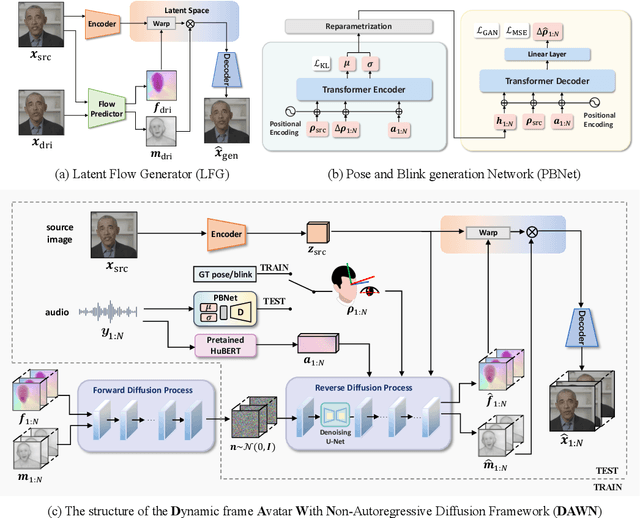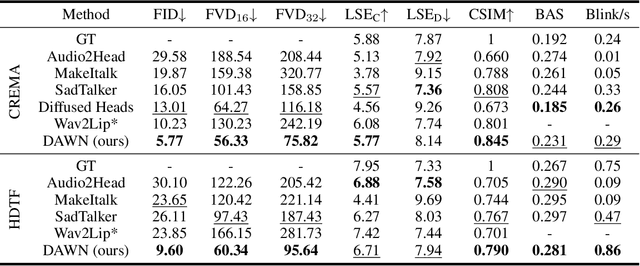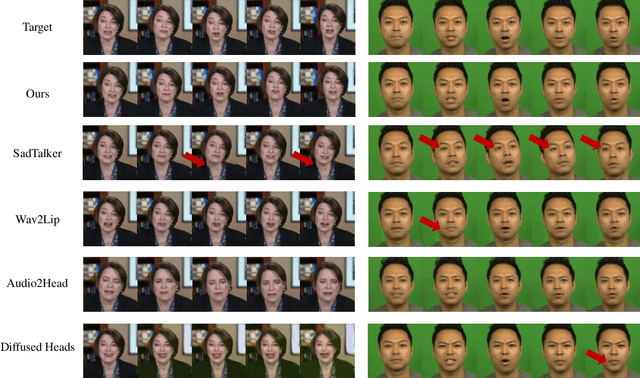Pengfei Hu
Video SimpleQA: Towards Factuality Evaluation in Large Video Language Models
Mar 24, 2025Abstract:Recent advancements in Large Video Language Models (LVLMs) have highlighted their potential for multi-modal understanding, yet evaluating their factual grounding in video contexts remains a critical unsolved challenge. To address this gap, we introduce Video SimpleQA, the first comprehensive benchmark tailored for factuality evaluation of LVLMs. Our work distinguishes from existing video benchmarks through the following key features: 1) Knowledge required: demanding integration of external knowledge beyond the explicit narrative; 2) Fact-seeking question: targeting objective, undisputed events or relationships, avoiding subjective interpretation; 3) Definitive & short-form answer: Answers are crafted as unambiguous and definitively correct in a short format, enabling automated evaluation through LLM-as-a-judge frameworks with minimal scoring variance; 4) External-source verified: All annotations undergo rigorous validation against authoritative external references to ensure the reliability; 5) Temporal reasoning required: The annotated question types encompass both static single-frame understanding and dynamic temporal reasoning, explicitly evaluating LVLMs factuality under the long-context dependencies. We extensively evaluate 41 state-of-the-art LVLMs and summarize key findings as follows: 1) Current LVLMs exhibit notable deficiencies in factual adherence, particularly for open-source models. The best-performing model Gemini-1.5-Pro achieves merely an F-score of 54.4%; 2) Test-time compute paradigms show insignificant performance gains, revealing fundamental constraints for enhancing factuality through post-hoc computation; 3) Retrieval-Augmented Generation demonstrates consistent improvements at the cost of additional inference time overhead, presenting a critical efficiency-performance trade-off.
Skeleton and Font Generation Network for Zero-shot Chinese Character Generation
Jan 14, 2025Abstract:Automatic font generation remains a challenging research issue, primarily due to the vast number of Chinese characters, each with unique and intricate structures. Our investigation of previous studies reveals inherent bias capable of causing structural changes in characters. Specifically, when generating a Chinese character similar to, but different from, those in the training samples, the bias is prone to either correcting or ignoring these subtle variations. To address this concern, we propose a novel Skeleton and Font Generation Network (SFGN) to achieve a more robust Chinese character font generation. Our approach includes a skeleton builder and font generator. The skeleton builder synthesizes content features using low-resource text input, enabling our technique to realize font generation independently of content image inputs. Unlike previous font generation methods that treat font style as a global embedding, we introduce a font generator to align content and style features on the radical level, which is a brand-new perspective for font generation. Except for common characters, we also conduct experiments on misspelled characters, a substantial portion of which slightly differs from the common ones. Our approach visually demonstrates the efficacy of generated images and outperforms current state-of-the-art font generation methods. Moreover, we believe that misspelled character generation have significant pedagogical implications and verify such supposition through experiments. We used generated misspelled characters as data augmentation in Chinese character error correction tasks, simulating the scenario where students learn handwritten Chinese characters with the help of misspelled characters. The significantly improved performance of error correction tasks demonstrates the effectiveness of our proposed approach and the value of misspelled character generation.
DynamicLip: Shape-Independent Continuous Authentication via Lip Articulator Dynamics
Jan 02, 2025Abstract:Biometrics authentication has become increasingly popular due to its security and convenience; however, traditional biometrics are becoming less desirable in scenarios such as new mobile devices, Virtual Reality, and Smart Vehicles. For example, while face authentication is widely used, it suffers from significant privacy concerns. The collection of complete facial data makes it less desirable for privacy-sensitive applications. Lip authentication, on the other hand, has emerged as a promising biometrics method. However, existing lip-based authentication methods heavily depend on static lip shape when the mouth is closed, which can be less robust due to lip shape dynamic motion and can barely work when the user is speaking. In this paper, we revisit the nature of lip biometrics and extract shape-independent features from the lips. We study the dynamic characteristics of lip biometrics based on articulator motion. Building on the knowledge, we propose a system for shape-independent continuous authentication via lip articulator dynamics. This system enables robust, shape-independent and continuous authentication, making it particularly suitable for scenarios with high security and privacy requirements. We conducted comprehensive experiments in different environments and attack scenarios and collected a dataset of 50 subjects. The results indicate that our system achieves an overall accuracy of 99.06% and demonstrates robustness under advanced mimic attacks and AI deepfake attacks, making it a viable solution for continuous biometric authentication in various applications.
Joint Knowledge Editing for Information Enrichment and Probability Promotion
Dec 22, 2024Abstract:Knowledge stored in large language models requires timely updates to reflect the dynamic nature of real-world information. To update the knowledge, most knowledge editing methods focus on the low layers, since recent probes into the knowledge recall process reveal that the answer information is enriched in low layers. However, these probes only and could only reveal critical recall stages for the original answers, while the goal of editing is to rectify model's prediction for the target answers. This inconsistency indicates that both the probe approaches and the associated editing methods are deficient. To mitigate the inconsistency and identify critical editing regions, we propose a contrast-based probe approach, and locate two crucial stages where the model behavior diverges between the original and target answers: Information Enrichment in low layers and Probability Promotion in high layers. Building upon the insights, we develop the Joint knowledge Editing for information Enrichment and probability Promotion (JEEP) method, which jointly edits both the low and high layers to modify the two critical recall stages. Considering the mutual interference and growing forgetting due to dual modifications, JEEP is designed to ensure that updates to distinct regions share the same objectives and are complementary. We rigorously evaluate JEEP by editing up to thousands of facts on various models, i.e., GPT-J (6B) and LLaMA (7B), and addressing diverse editing objectives, i.e., adding factual and counterfactual knowledge. In all tested scenarios, JEEP achieves best performances, validating the effectiveness of the revealings of our probe approach and the designs of our editing method. Our code and data are available at https://github.com/Eric8932/JEEP.
RFL: Simplifying Chemical Structure Recognition with Ring-Free Language
Dec 10, 2024



Abstract:The primary objective of Optical Chemical Structure Recognition is to identify chemical structure images into corresponding markup sequences. However, the complex two-dimensional structures of molecules, particularly those with rings and multiple branches, present significant challenges for current end-to-end methods to learn one-dimensional markup directly. To overcome this limitation, we propose a novel Ring-Free Language (RFL), which utilizes a divide-and-conquer strategy to describe chemical structures in a hierarchical form. RFL allows complex molecular structures to be decomposed into multiple parts, ensuring both uniqueness and conciseness while enhancing readability. This approach significantly reduces the learning difficulty for recognition models. Leveraging RFL, we propose a universal Molecular Skeleton Decoder (MSD), which comprises a skeleton generation module that progressively predicts the molecular skeleton and individual rings, along with a branch classification module for predicting branch information. Experimental results demonstrate that the proposed RFL and MSD can be applied to various mainstream methods, achieving superior performance compared to state-of-the-art approaches in both printed and handwritten scenarios. The code is available at https://github.com/JingMog/RFL-MSD.
MPLite: Multi-Aspect Pretraining for Mining Clinical Health Records
Nov 17, 2024Abstract:The adoption of digital systems in healthcare has resulted in the accumulation of vast electronic health records (EHRs), offering valuable data for machine learning methods to predict patient health outcomes. However, single-visit records of patients are often neglected in the training process due to the lack of annotations of next-visit information, thereby limiting the predictive and expressive power of machine learning models. In this paper, we present a novel framework MPLite that utilizes Multi-aspect Pretraining with Lab results through a light-weight neural network to enhance medical concept representation and predict future health outcomes of individuals. By incorporating both structured medical data and additional information from lab results, our approach fully leverages patient admission records. We design a pretraining module that predicts medical codes based on lab results, ensuring robust prediction by fusing multiple aspects of features. Our experimental evaluation using both MIMIC-III and MIMIC-IV datasets demonstrates improvements over existing models in diagnosis prediction and heart failure prediction tasks, achieving a higher weighted-F1 and recall with MPLite. This work reveals the potential of integrating diverse aspects of data to advance predictive modeling in healthcare.
LLM-Neo: Parameter Efficient Knowledge Distillation for Large Language Models
Nov 11, 2024Abstract:In this paper, we propose a novel LLM-Neo framework that efficiently transfers knowledge from a large language model (LLM) teacher to a compact student. Initially, we revisit the knowledge distillation (KD) and low-rank adaption (LoRA), and argue that they share the same paradigm. Inspired by this observation, we explore the strategy that combines LoRA and KD to enhance the efficiency of knowledge transfer. We first summarize some guidelines for this design and further develop the LLM-Neo. Experimental results on compressing Llama 2 and Llama 3 show that LLM-Neo outperforms various baselines. Further analysis demonstrates the robustness of the proposed LLM-Neo on variants of LoRA. The trained models have been available at \href{https://huggingface.co/collections/yang31210999/llm-neo-66e3c882f5579b829ff57eba}{this repository}.
DualMAR: Medical-Augmented Representation from Dual-Expertise Perspectives
Oct 25, 2024Abstract:Electronic Health Records (EHR) has revolutionized healthcare data management and prediction in the field of AI and machine learning. Accurate predictions of diagnosis and medications significantly mitigate health risks and provide guidance for preventive care. However, EHR driven models often have limited scope on understanding medical-domain knowledge and mostly rely on simple-and-sole ontologies. In addition, due to the missing features and incomplete disease coverage of EHR, most studies only focus on basic analysis on conditions and medication. We propose DualMAR, a framework that enhances EHR prediction tasks through both individual observation data and public knowledge bases. First, we construct a bi-hierarchical Diagnosis Knowledge Graph (KG) using verified public clinical ontologies and augment this KG via Large Language Models (LLMs); Second, we design a new proxy-task learning on lab results in EHR for pretraining, which further enhance KG representation and patient embeddings. By retrieving radial and angular coordinates upon polar space, DualMAR enables accurate predictions based on rich hierarchical and semantic embeddings from KG. Experiments also demonstrate that DualMAR outperforms state-of-the-art models, validating its effectiveness in EHR prediction and KG integration in medical domains.
DAWN: Dynamic Frame Avatar with Non-autoregressive Diffusion Framework for Talking Head Video Generation
Oct 17, 2024



Abstract:Talking head generation intends to produce vivid and realistic talking head videos from a single portrait and speech audio clip. Although significant progress has been made in diffusion-based talking head generation, almost all methods rely on autoregressive strategies, which suffer from limited context utilization beyond the current generation step, error accumulation, and slower generation speed. To address these challenges, we present DAWN (Dynamic frame Avatar With Non-autoregressive diffusion), a framework that enables all-at-once generation of dynamic-length video sequences. Specifically, it consists of two main components: (1) audio-driven holistic facial dynamics generation in the latent motion space, and (2) audio-driven head pose and blink generation. Extensive experiments demonstrate that our method generates authentic and vivid videos with precise lip motions, and natural pose/blink movements. Additionally, with a high generation speed, DAWN possesses strong extrapolation capabilities, ensuring the stable production of high-quality long videos. These results highlight the considerable promise and potential impact of DAWN in the field of talking head video generation. Furthermore, we hope that DAWN sparks further exploration of non-autoregressive approaches in diffusion models. Our code will be publicly at https://github.com/Hanbo-Cheng/DAWN-pytorch.
t-READi: Transformer-Powered Robust and Efficient Multimodal Inference for Autonomous Driving
Oct 13, 2024Abstract:Given the wide adoption of multimodal sensors (e.g., camera, lidar, radar) by autonomous vehicles (AVs), deep analytics to fuse their outputs for a robust perception become imperative. However, existing fusion methods often make two assumptions rarely holding in practice: i) similar data distributions for all inputs and ii) constant availability for all sensors. Because, for example, lidars have various resolutions and failures of radars may occur, such variability often results in significant performance degradation in fusion. To this end, we present tREADi, an adaptive inference system that accommodates the variability of multimodal sensory data and thus enables robust and efficient perception. t-READi identifies variation-sensitive yet structure-specific model parameters; it then adapts only these parameters while keeping the rest intact. t-READi also leverages a cross-modality contrastive learning method to compensate for the loss from missing modalities. Both functions are implemented to maintain compatibility with existing multimodal deep fusion methods. The extensive experiments evidently demonstrate that compared with the status quo approaches, t-READi not only improves the average inference accuracy by more than 6% but also reduces the inference latency by almost 15x with the cost of only 5% extra memory overhead in the worst case under realistic data and modal variations.
 Add to Chrome
Add to Chrome Add to Firefox
Add to Firefox Add to Edge
Add to Edge